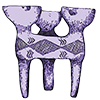Female Circumcision against the Backdrop of Istanbul Convention
DOI:
https://doi.org/10.33831/jws.v20i1.48Keywords:
female circumcision, female genital mutilation (FMG), clitoridectomy, misogyny, Istanbul ConventionAbstract
Between social activists and feminists, the fight against female circumcision (Female Genital Mutilation) is an important policy objective. FGM, sometimes referred to as female circumcision or female genital cutting, is to cut down the clitoris of girls and women to reduce their sexual desires and to protect their sexual dignity before marriage. There is also a slight confusion over the two concepts that are defined as female genital mutilation and female circumcision. In fact, although two terms can be used interchangeably, it is also obvious that they carry two different connotations. The practice that is said to be common in Muslim countries is a huge cost: many girls die from blood loss or infection. Most have become traumatized. Survivors may experience adverse health effects during marriage and pregnancy. New information from Iraqi Kurdistan reveals that the problem is also widespread in the Middle East.
This article will be preceded by relevant concepts / terminology and will be assessed for the different methods / types applied. Later on, the reason for this process will be the importance in terms of history and religions, the clitoridectomy in the West, the relationship with this woman's sexuality and misogyny, and the female circumcision will be examined under the Istanbul Convention.
References
Abu-Sahlieh S.A.A. (2001) Male and Female Circumcision among Jews, Christians and Muslims: Religious, Medical, Social and Legal Debate. Warren Center, PA: Shangri La Publications.
Akkayan T. (2010) Bedenin Kültürel Gerekçelerle Sakatlanması ve Söğüt’te Sünnet. Antropoloji, 24: 37-68.
Baker B.I. (2017). On the Curability of Certain Forms of Insanity, Epilepsy, Catalepsy and Hysteria in Females (İlk basım 1866). Londra: Hardwicke. İnternet adresi: https://books.google.com.tr/books?id=IhjA0TqeSIkC&pg=PP7&hl=tr&source=gbs_selected_pages&cad=2#v=onepage&q&f=false. Erişim tarihi: 07.12.2017.
Barker-Benfield G.J. (2014). The Horrors of the Half-Known Life: Male Attitudes toward Women and Sexuality in 19th Century America (İlk basım 1976,). New York: Routledge.
Bayık F. (1985) Söğüt’te Sünnet. İstanbul Üniversitesi Edebiyat Fakültesi Antropoloji Bölümü Yayınlanmamış Lisans Bitirme Çalışması, İstanbul.
Burrage H. (2015). Eradicating Female Genital Mutilation UK Perspective. London: Routledge.
BBC (2014). Female Circumcision/Genital Cutting. BBC ethical Guide. İnternet adresi: http://www.bbc.co.uk/ethics/femalecircumcision/femalecirc_1.shtml. Erişim tarihi: 07.12.2017.
Erskine K. (2014). Collecting Data on Female Genital Mutilation. British Journal of Urology International, 348: g3222.
Constantinides P. (1985). Women Heal Women: Spirit Possession and Sexual Segregation in a Muslim Society. Social Science and Medicine, 21(6): 685-692.
Dinçkal F. (2013). Matriyar Toplumlar, Tanrı Anlayışı ve Etkileri. Anadolu Aydınlanma Vakfı. İnternet adresi: http://www.anadoluaydinlanma.org/anadolu/matriyar_toplumlar.pdf. Erişim tarihi: 07.12.2017.
Drenth J. (2007). The Origin of the World: Science and Fiction of the Vagina (Dünyanın Kökeni Vajina) (Çev: Mefkûre Bayatlı). İstanbul: Agora Kitaplığı.
Duffin J. (2016). History of Medicine: A Scandalously Short Introduction (2. Basım). University of Toronto Press.
Dunsmuir W.D. & Gordon E.M. (1999) The History of Circumcision. BJU Intertational, 83(19): 1-12.
Erbil P. (2007). Kibele’den Pandora’ya Kadının Tarihsel Yenilgisi. Ankara: Arkadaş Yayınevi.
FORWARD (Foundation for Women's Health Research and Development), UK (2006). Definitions and Terms for FGM. İnternet adresi: http://www.forwarduk.org.uk/key.issues/fgm/definitions. Erişim tarihi: 07.12.2017.
Sigmund F. (First published 1939). Moses and Monotheism. London: The Hogarth Press and the Institute of Psycho-Analysis. İnternet adresi: https://archive.org/stream/mosesandmonothei032233mbp/mosesandmonothei032233mbp_djvu.txt. Erişim tarihi: 07.12.2017.
Sigmund F. (1989). Some Psychical Consequences of the Anatomical Differences between the Sexes. New York: W.W. Norton and Company.
Gollaher D.L. (2000). Circumcision: A History of the World’s Most Controversial Surgery. New York: Basic Books.
Herodotos (1973). Herodot Tarihi (Çev: Müntekim Ökmen-Azra Erhat). İstanbul:Remzi kitabevi.
Holland J. (2016). A Brief History of Misogyny: The World’s Oldest Prejudice (Mizojini Dünyanın En Eski Önyargısı, Kadından Nefretin Evrensel Tarihi) (Çev: Erdoğan Okyay). Ankara: İmge Kitabevi Yayınları.
Hoving I., Korsten F.W. & Van Alphen E. (2003). Africa and Its Significant Others: Forty Years of Intercultural Entanglement. Netherlands: Rodopi Publication.
Avrupa Konseyi (2011). İstanbul Sözleşmesi -Kadınlara Yönelik Şiddet ve Ev İçi Şiddetin Önlenmesi ve Bunlarla Mücadele Hakkındaki Avrupa Konseyi Sözleşmesi (Türkiyede 1 Ağustos 2014 tarihinde yürürlüğe girmiştir). İnternet adresi: http://www.resmigazete.gov.tr/eskiler/2012/03/2012030 8M1-1.pdf. Erişim tarihi: 07.12.2017.
Jackson M. (2018). A Global History of Medicine. Oxford University Press, Kofman S. (1985). The Enigma of Woman in Freud’s Writings (Fransızcadan İngilizceye çeviren Catherina Porter). Cornell University Press
Eagan J. (2002). Enigmas: Essays on Sarah Kofman (review). Hypatia, 17(3): 271-273. İnternet adresi: http://users.clas.ufl.edu/burt/%20%20%20glossator%20%201/NIetzschenachgloss/Nietzsche%20Nachlass%20%20DerridaPost%20Card/17.3eagan.pdf. Erişim tarihi: 07.12.2017.
Kouba L. & Muasher J. (1985). Female Circumcision in Africa: An Overview. African Studies Review, 28 (1): 95-110.
Köse A. (1998). Musa ve Tektanrıcılık: Bir Tarih Psikanalizinin Açmazları. Divan Dergisi, 1: 37-56.
Kolektif (2001). Kutsal Kitap: Eski ve Yeni Antlaşma: Tevrat, Zebur, İncil. İstanbul: Yeni Yaşam Yayınları.
Lightfoot-Klein H. (1989). Prisoners of Ritual: An Odyssey into Female Genital Circumcision in Africa. New York: Haworth Press.
Lockhat H. (2004) Female Genital Mutilation: Treating the Tears. Middlesex University Press.
Özmen M.C. (2011). İslâm Dışı Bir Uygulama: Çocuk Sünneti. Türkiyenin Yazar Portalı. İnternet adresi: http://www.yazarportal.com/islam-disi-bir-uygulamacocuk-sunneti/50183/.
Rouzi A.A. (2013). Facts and Controversies on Female Genital Mutilation and Islam. The European Journal of Contraception & Reproductive Health Care, 18(1):10-14.
Stephens W. (2002). Demon Lovers: Witchcraft, Sex and the Crises of Blief. Chicago: University of Chicago Press.
UNICEF (2010). Legislative Reform to Support the Abandonment of Female Genital Mutilation/Cutting. New York: UNICEF.
UNICEF (2013). Female Genital Mutilation/Cutting: A Statistical Overview and Exploration of the Dynamics of Change. New York: UNICEF. İnternet adresi: http://www.unicef.org/media/files/FGCM_Lo_res.pdf. Erişim tarihi: 7.12.2017.
Uzak Meryem (2010) Kuran ve Sünnete Göre İnsan Bedenine Yönelik Estetik Amaçlı Müdahaleler, Harran Üniversitesi Sosyal Bilimler Enstitüsü Temel İslam Bilimleri Ana Bilim Dalı Hadis Bilim Dalı Yüksek Lisans Tezi.
Van Der Kwaak A. (1992). Female Circumcision and Gender Identity: A Questionable Alliance? Social Science and Medicine, 35(6):777-787.
Walker A. (2011). Possessing the Secret of Joy. Open Road Media publication. İnternet adresi: https://books.google.com.tr/books/about/Possessing_the_Secret_of_Joy.html?id=Wvyg0lWa7GcC&redir_esc=y. Erişim tarihi: 07.12.2017.
WHO (World Health Organisation) (2008). Eliminating Female Genital Mutilation: An Interagency Statement. Geneva: WHO. İnternet adresi: http://apps.who.int/iris/bitstream/handle/10665/43839/9789241596442_eng.pdf;jsessionid=FCB3C4F33E0E9CE9895FF2C5B98CC4AB?sequence=1. Erişim tarihi: 07.12.2017.
WHO (2014). Female Genital Mutilation. Fact Sheet No 241. İnternet adresi: http://www.who.int/mediacentre/factsheets/fs241/en. Erişim tarihi: 07.12.2017.
Yoder PS. & Khan S. (2007). Numbers of Women Circumcised in Africa: The Production of a Total. Calverton: Macro International Inc.
Downloads
Published
Issue
Section
License
Authors who publish with this journal agree to the following terms:
- Authors retain copyright and grant the journal right of first publication, with the work [6 months] after publication simultaneously licensed under a Creative Commons Attribution License that allows others to share the work with an acknowledgement of the work's authorship and initial publication in this journal.
- Authors are able to enter into separate, additional contractual arrangements for the non-exclusive distribution of the journal's published version of the work (e.g., post it to an institutional repository or publish it in a book), with an acknowledgement of its initial publication in this journal.
- Authors are permitted and encouraged to post their work online (e.g., in institutional repositories or on their website) prior to and during the submission process, as it can lead to productive exchanges, as well as earlier and greater citation of published work (See The Effect of Open Access)







